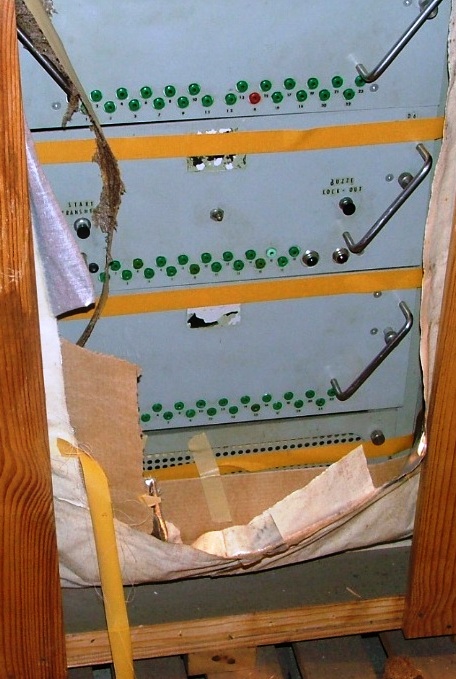 |
| Still dressed in its shipping wrap, the KY-1
consists of the following units:
KYB-1
K=Cryptographic, Y=Speech, B=base cabinet, K=Keying, I=Translator or reader, D=Drawer or panel, S=Synchronizing Dimensions
NCM artifact number: 2009.0319.1103
|
The TSEC/KY-1 was an all tube, 50 KHz voice encryptor . The key generator was an nightmare to adjust. It was controlled by a key card, just like the KY-3. Because it was a 50 KHz wide band device, it was restricted for local use to posts, camps or hardened sites.John Heimer was a USAF Electronic Communications and Cryptographic Equipment Technician (306X0) from 1960-1983, and was trained on many crypto systems including KY-1.
"I entered Crypto training at Lackland AFB on January 4th, 1961 (class 010461), which was a secure voice encryption system (Ciphony) class - KY-1 and KO-6. Due to a USAF needs decision, I only trained on the KY-1 before my class converted to another system (KW-26). After school, I was assigned to an Air Force Security Service unit (6922 RGM) on Okinawa in October, 1961, where I was one of two individuals trained on the KY-1.
As stated in your KY-1 summary line , it was tube-based, 50 KHz wideband device, and as it turned out, a not so secure voice encryption system It was a three combination, military grey safe that contained the key generator, power supply, digitizing voice preparation components-everything except the push -to-talk handset which sat on top. The push-to-talk function annoyed most users, because it was difficult to interrupt conversations.
The equipment (in our case) was located in the Commander’s office. Other than the daily key card changes and periodic preventive maintenance, there should have been little reason to ever see the unit.
The internal electronics was very voltage sensitive, and the unit would alarm out whenever the input power became even slightly unstable. To ensure stable internal power, a somewhat complicated power supply was in place, which included a small servo device that reacted to the most minor input voltage fluctuations; the servo was connected to a potentiometer to maintain voltage levels. That servo was a major problem in that it would hang up, resulting in an alarm condition. This happened at least once a week, with the “fix” being to tap the servo with a rubber mallet, which caused it to release and stabilize. The KY-1 equipment was a design that was not thought out properly.
In reference to the security of the system, sometime in early 1962, it was discovered that red (clear voice) would be transmitted in the event of a specific tube failure in the MOD2 adder circuitry and the system was immediately removed from world-wide service around the May/June time frame of 1962, and I never saw it again". This last statement needs collaboration.
From Frode Weierud:
"The in-service date for the KY-1 is believed to be circa 1961 while the out-of-service date is 1967. The idea for a new speech encryptor was conceived in mid 1954 and in 1955 the KY-1 was still on the drawing boards. Cycle studies for the key generator were concluded in November 1956 and the final KY-1 development report was published in 1958. The first descriptive report, "Half-duplex, Wide Band Speech Security Equipment (TSEC/KY-1),” is dated 5 March 1958 with a revised version published on 27 August 1959. In September 1962 a crypto security evaluation report for the KY-1 (JANUS) was completed, however as far as I know aTempest problem with the KY-1 was discovered later on, probably closer to when it was taken out of service."KY-3 was the follow-on equipment to the KY-1.
 |
| Still dressed in its shipping wrap, the KY-1
consists of the following units:
KYB-1
K=Cryptographic, Y=Speech, B=base cabinet, K=Keying, I=Translator or reader, D=Drawer or panel, S=Synchronizing Dimensions
NCM artifact number: 2009.0319.1103
|
Contributors:1) George Mace <gmace8(at)comcast.net>
2) John Heifer <johnandmari64(at)gmail.com>
3) NCM https://5099.sydneyplus.com/final/Portal/Default.aspx?lang=en-US&g_AABJ=2009.0319.1103\4)
4) 1955 inservice date https://www.nsa.gov/Portals/75/documents/news-features/declassified-documents/friedman-documents/reports-research/FOLDER_059/41711049075036.pdf
5) Frode Weierud <frode.weierud(at)gmail.com>
6) Richard Hammond <ciphonytek(at)yahoo.com>
Mar 20/23